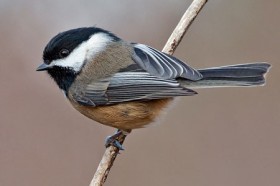SIGNS OF SPRING: Dragonflies and Hummingbirds
“Tra La. It’s here.” It is May. A song from the musical Camelot refers to this as the “lusty month of May” and at Crossroads at Big Creek, that indeed is the case.
The beautiful bird songs of May are produced by male birds advertising the boundaries of their nesting territories. The assumption was that the males sing to keep other males of their species away from their mates. And that is still true.
I has always believed that these territorial signs had worked rather well. So then why, now that scientists can do sophisticated genetic testing, are they finding that an average 30 percent of baby birds in a nest are fathered by some bird other than the mate of the female. Hummm.
Are the singing males so preoccupied with their vocal production that they are oblivious to the carrying-on in their territories?
Are some males just good at breaching melodic fences? Just how do male birds cuckold their avian neighbors?
Ah the finger of suspicion points the wrong direction.. It’s not the males that are running (or flying) around. The females–the mothers–of a number of our favorite songbird species are promiscuous.
A researcher named Susan Smith found evidence of this licentious behavior in a flock of chickadees.
It’s apparent to anyone who watches birds that chickadees have a pecking order—a social hierarchy. It turns out that only the highest status pairs of chickadees in each flock build nests and raise young.
The highest status male and the highest status females form a pair. Number two male and number two female set up nest keeping and number three mates with number three and so on. You get the idea. And you would assume that the paired birds were monogamous.
So let think for a moment about female number four or maybe number five. Her mate is OK….not that bad…certainly not one of the whimp males that will never breed, but he is nothing special. So…the low-ranking female flits off to mate with the highest status male.
The result is that the lower status female obtains higher quality genes for at least some of her offspring without risking the loss of her own mate who will share the chick-raising duties. Loyal to mate? yes. Monogamous? not so much.
This may sound very intentional, but I really don’t believe that birds are social climbers and I sincerely doubt that they have any idea that the act of mating leads to baby birds. Certainly, female birds don’t sit up in their little nests, scheming how they can improve the genetic makeup of their offspring or further survival success of their species as a whole. But it happens.
Another weird sounding behavior which helps account for the mixed parentage of the nest full of mixed-parentage birds is called “egg dumping” A female bird lays (dumps) an egg in a nest not her own. The advantage of this should be obvious.
If the mother’s own nest is damaged by a storm or predator, her offspring in the other nest may survive. This, too, is remarkable. How do mother birds know to do this?
When I was in school, the prevailing belief was that 90 percent of birds were monogamous. Still today. most books state that birds are loyal to their mates. But in the wonderful reference “The Birder’s Handbook” Ehrick, Dobkin, and Wheye state: “At the moment it is perhaps best simply to consider monogamy as a social pattern in which one male and one female associate during the breeding season [the lusty month of May] and not to make so man assumptions about fidelity or parentage.”


